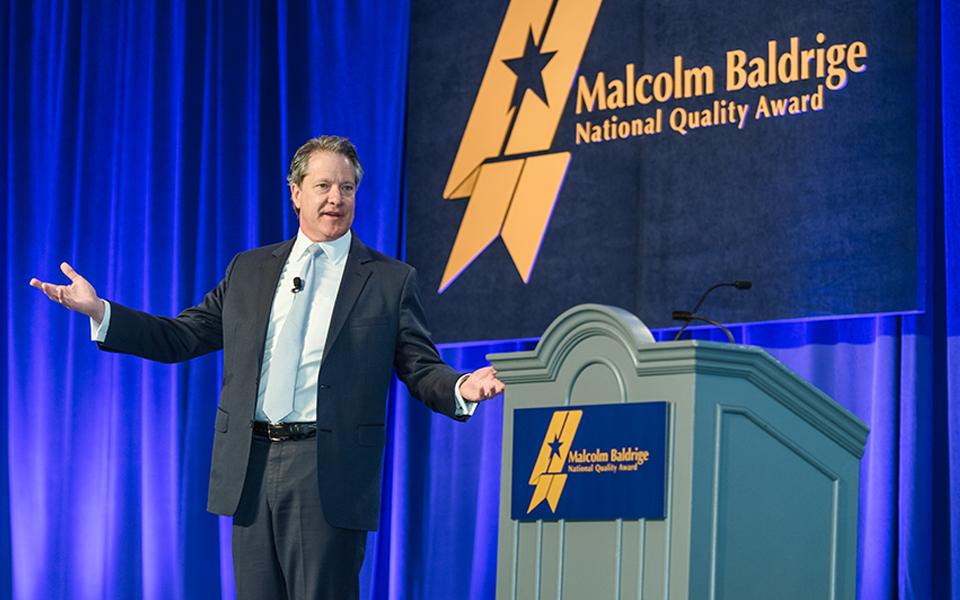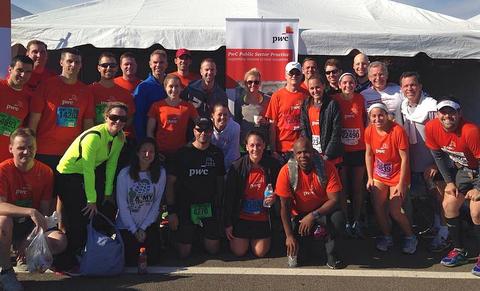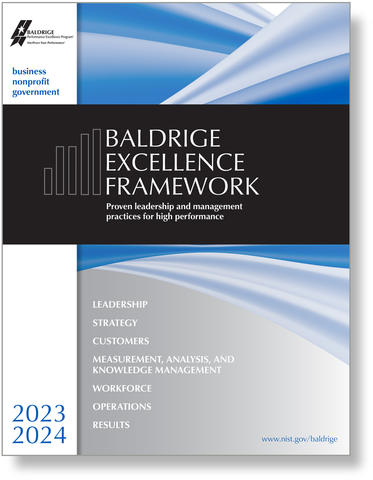Blogrige
The Official Baldrige Blog

Scott McIntyre speaking during Guidehouse's Quest for Excellence innovation presentation.
Five-Part Leadership Blog Series
Senior leaders of five recent Baldrige Award recipients representing diverse sectors of the U.S. economy—The Charter School of San Diego (CSSD), Elevations Credit Union, Guidehouse (formerly PricewaterhouseCoopers Public Sector), Memorial Hermann Sugar Land Hospital, and Stellar Solutions—presented insights on how they guide their high-performing organizations to innovate at the Baldrige Performance Excellence Program’s 34th Quest for Excellence® conference in April 2023. Following are highlights of the presentation by Scott McIntyre of Guidehouse.
“A Deep, Deep Commitment to the Baldrige Framework”

Scott McIntyre started the Virginia-based financial services practice known as PricewaterhouseCoopers Public Sector in 2005 as a subunit of PricewaterhouseCoopers (PwC), serving as its managing partner as its revenue grew from zero to $600 million and leading his team in 2014 (as shown in photo) to become a Baldrige Award recipient.
Five years ago, the Baldrige Award-winning organization became Guidehouse as part of a financial acquisition that made it independent of PwC. Currently, Guidehouse is passing the $3 billion threshold for revenue, according to McIntyre, who serves as CEO.
How did he lead such growth, both at PricewaterhouseCoopers Public Sector and now at Guidehouse?
“One of the biggest stimulants to our growth—our resiliency through tough economic conditions—and frankly, our ability to rapidly increase our client base around the world, was a deep, deep commitment to the Baldrige framework,” he said.
McIntyre recalled that in the years before 2014, “We aggressively pursued the [Baldrige] framework, naively thinking that we’d win the [Baldrige] award very quickly.” Despite the fact that it took the organization at least “three shots” of participating in the annual evaluation process before it earned a Baldrige Award, according to McIntyre, he made clear that those early years of pursuing improvements were beneficial.
“One of the greatest things about that journey for us,” he said, “was the constant learning.” Among lessons the organization learned through its Baldrige journey is “to hold yourself to a standard that says, ‘we need to constantly improve this business.’”
“We came up with an internal concept that if we’re not getting better faster than our competition is, then we’re getting worse,” he said, adding that Guidehouse continues to “hold dear, even today” this concept as its mantra and philosophy.
Guidehouse’s Innovation Model
“We’re looking at innovating things like our business model, innovating how we … attract and treat customers, innovating how we treat our employees,” said McIntyre, explaining how Guidehouse’s approach to innovation is different from that of other organizations, such as a technology business that may pursue innovative technologies for new products that it can patent.
McIntyre also explained that Guidehouse’s approach to innovation does not aim to be merely competitive: “Creatively, if we’re constantly thinking about innovating like our toughest and staunchest competitors are innovating, we’re, at best, … going to meet the mean of our competitive innovation profile. We don’t want that. We want to be disruptive.”
So Guidehouse looks at innovation through three lenses, he said. Those include “differentiated collaboration,” which McIntyre described as collaboration around teamwork in relation to the 12 countries and 52 locations in which Guidehouse operates today. “Many of our competitors in management and technology consulting operate in very siloed functions,” said McIntyre, “and we wanted to tap into collaboration and teamwork in a way that none of our competitors had.” He credited this collaboration for a significant amount of Guidehouse’s growth over the past five years.
“Our big story about innovation is how we can go to a client anywhere in the world and deliver any of our 16,000 people, seamlessly, effortlessly, effectively, and pinpoint the right people to our client’s biggest challenges or opportunities,” he said. “That’s very unique, and we see that as scalable even as we exceed the 20,000 employee base, which we expect to [do] in the next 18 months and beyond.”
“Seeking Innovation Everywhere across the Firm”
The other two focus areas of Guidehouse’s innovation model are “harvesting innovation everywhere” and “obsessing on core competencies.”
“The ability to harvest ideas is really critical to us, so we’ve come up with a number of ways to effectively tap into the creativity of all of our people,” said McIntyre.
For example, Guidehouse holds a monthly open forum where all employees can listen or offer ideas about what they’re seeing in terms of industry trends, client needs, regulatory changes, and insights for the organization’s strategy. In addition, Guidehouse has a capital vestment committee that includes not only senior leaders but also staff members and managers from all levels and locations. Guidehouse also holds an innovation contest every year in which any employee can share his or her ideas in a virtual space.
In relation to the third area of Guidehouse’s innovation model, McIntyre said that the organization has invested more than $15 million in developing the core competencies that differentiate it from its competitors.
After pointing out that Guidehouse went from being a nonexistent brand five years ago to one of the top-20 brands in management consulting today, McIntyre said, “Most of our competitors in the top 20 have about a 100-year head start on us.” He credited his organization’s use of the Baldrige framework for helping it grow and succeed.
“Without us committing to the Baldrige framework—the disciplines of taking that framework very seriously and implementing it into everything we can practically implement it into across our enterprise, galvanizing our focus on a commitment to that quality framework and getting people really rallied around not just understanding it and embedding it into their operations but really living it and evangelizing it across our company and with our clients—we would be a fraction of our size. In fact, I think it’s reasonable to say we might not even exist today. So we owe a lot to Baldrige.”
Five-Part Leadership Blog Series
Previous Blogs
Leading for Innovation, Part 1: Insights from CSSD’s Mary Bixby
Leading for Innovation, Part 2: Insights from Elevations Credit Union's Gerry Agnes
Upcoming Blogs
Leading for Innovation, Part 4: Insights from Memorial Hermann’s Malisha Patel
Leading for Innovation, Part 5: Insights from Stellar Solutions' Janet Grondin

Baldrige Excellence Framework®
The Baldrige Excellence Framework® has empowered organizations to accomplish their missions, improve results, and become more competitive. It includes the Criteria for Performance Excellence®, core values and concepts, and guidelines for evaluating your processes and results.
Purchase your copy today!
Available versions: Business/Nonprofit, Education, and Health Care





